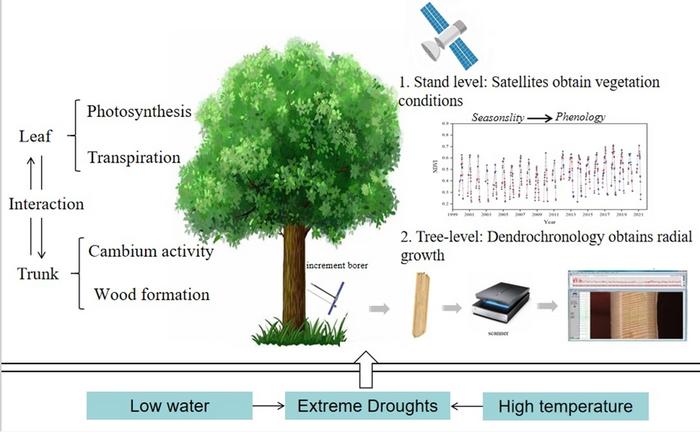A recent study from China has shed light on the profound impacts of extreme droughts on forest ecosystems, particularly in water-limited regions. The findings revealed significant differences in how various tree species respond to such stressors.

Credit: Shi, Han, et al.,
A recent study from China has shed light on the profound impacts of extreme droughts on forest ecosystems, particularly in water-limited regions. The findings revealed significant differences in how various tree species respond to such stressors.
Conducted in the Horqin Sandy Land of Northeast China, the research used dendrochronology and remote sensing techniques to examine the responses of both native maple-oak forests and introduced poplar plantations to extreme drought conditions. The study’s findings, published in the KeAi journal Forest Ecosystems, underscore the critical role of precipitation and the self-calibrated Palmer Drought Severity Index (scPDSI) in influencing tree growth and vegetation health.
The severe droughts experienced between 2000 and 2004 led to notable declines in radial growth and vegetation index (NDVI) across the studied tree species. The impact was particularly severe on the poplar species, with fast-growing poplar species showing more dramatic declines in growth rates and vegetation health than native maple and oak species. This indicates a species-specific trade-off between drought resilience and growth rate, with fast-growing species like poplar being more vulnerable to drought conditions.
Moreover, the study discovered that while radial growth showed no significant correlation with scPDSI, NDVI demonstrated a significant positive correlation, highlighting the greater sensitivity of canopy performance to drought stress than on the scale of inter-annual events radial growth.
These insights are crucial for forest management and afforestation efforts, especially in the context of climate change. Understanding species-specific responses to extreme droughts can guide the selection of tree species that are better suited to withstand water-limited conditions, ensuring the sustainability and resilience of forest ecosystems.
###
Contact the author: Han Shi, CAS Key Laboratory of Forest Ecology and Silviculture, Institute of Applied Ecology, Chinese Academy of Sciences, Shenyang, China, [email protected]
The publisher KeAi was established by Elsevier and China Science Publishing & Media Ltd to unfold quality research globally. In 2013, our focus shifted to open access publishing. We now proudly publish more than 100 world-class, open access, English language journals, spanning all scientific disciplines. Many of these are titles we publish in partnership with prestigious societies and academic institutions, such as the National Natural Science Foundation of China (NSFC).
Journal
Forest Ecosystems
DOI
10.1016/j.fecs.2024.100209
Method of Research
Experimental study
Subject of Research
Not applicable
Article Title
Resilience and response: Unveiling the impacts of extreme droughts on forests through integrated dendrochronological and remote sensing analyses
COI Statement
The authors declare that they have no known competing financial interests or personal relationships that could have appeared to influence the work reported in this paper.




